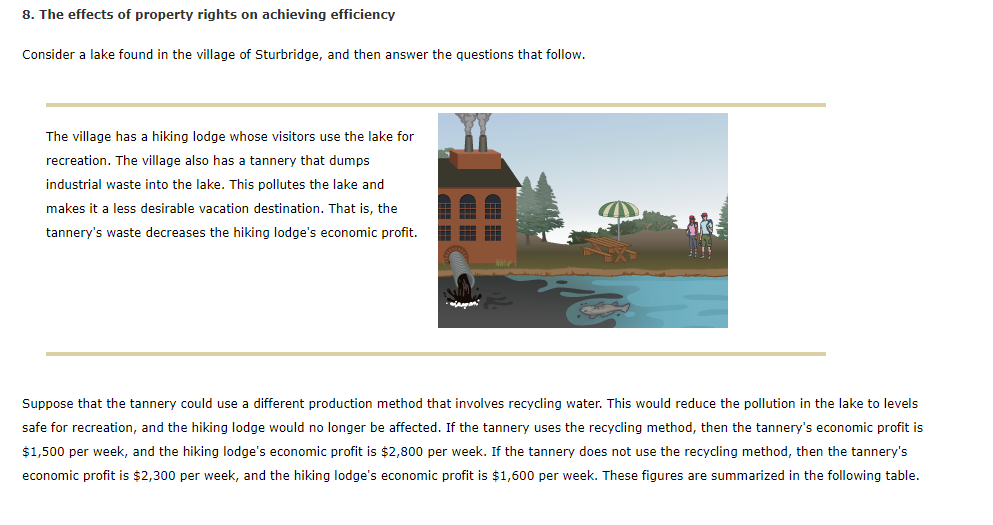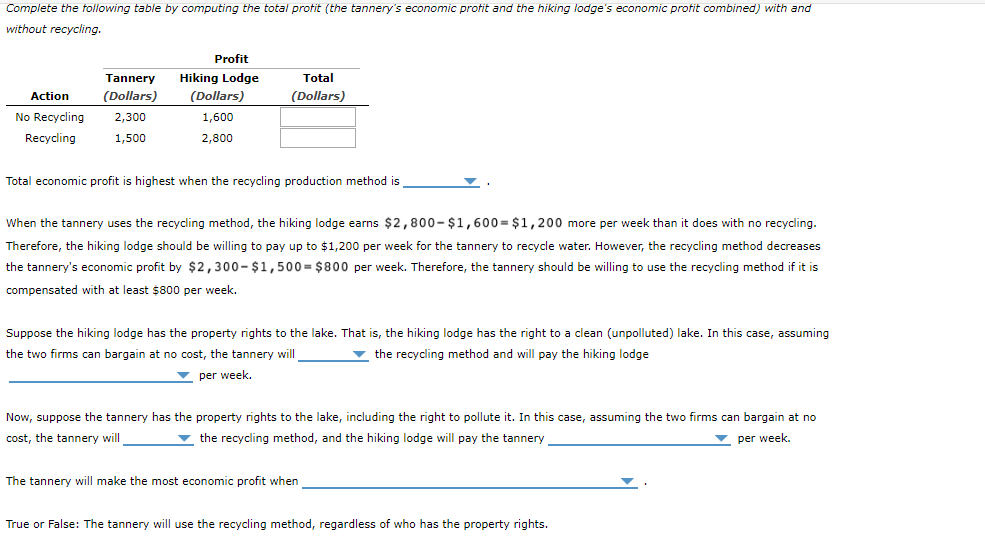8. The effects of property rights on achieving efficiency Consider a lake found in the village of Sturbridge, and then answer the questions that follow. The village has a hiking lodge whose visitors use the lake for recreation. The village also has a tannery that dumps industrial waste into the lake. This pollutes the lake and makes it a less desirable vacation destination. That is, the tannery's waste decreases the hiking lodge's economic profit. Aa Suppose that the tannery could use a different production method that involves recycling water. This would reduce the pollution in the lake to levels safe for recreation, and the hiking lodge would no longer be affected. If the tannery uses the recycling method, then the tannery's economic profit is $1,500 per week, and the hiking lodge's economic profit is $2,800 per week. If the tannery does not use the recycling method, then the tannery's economic profit is $2,300 per week, and the hiking lodge's economic profit is $1,600 per week. These figures are summarized in the following table. Complete the tollowing table by computing the total protit (the tannery's economic protit and the hiking lodge's economic protit combined) with and without recycling. Profit Total Hiking Lodge Tannery (Dollars) (Dollars) (Dollars) Action No Recycling 2,300 1,600 Recycling 1,500 2,800 Total economic profit is highest when the recycling production method is When the tannery uses the recycling method, the hiking lodge earns $2,800- $1,600=$1,200 more per week than does with no recycling. Therefore, the hiking lodge should be willing to pay up to $1,200 per week for the tannery to recycle water. However, the recycling method decreases the tannery's economic profit by $2,300-$1,500= $800 per week. Therefore, the tannery should be willing to use the recycling method if it is compensated with at least $800 per week. Suppose the hiking lodge has the property rights to the lake. That is, the hiking lodge has the right to a clean (unpolluted) lake. In this case, assuming the two firms can bargain at no cost, the tannery will the recycling method and willl pay the hiking lodge per week Now, suppose the tannery has the property rights to the lake, including the right to pollute it. In this case, assuming the two firms can bargain at no the recycling method, and the hiking lodge will pay the tannery cost, the tannery will per week The tannery will make the most economic profit when True or False: The tannery will use the recycling method, regardless of who has the property rights.
8. The effects of property rights on achieving efficiency Consider a lake found in the village of Sturbridge, and then answer the questions that follow. The village has a hiking lodge whose visitors use the lake for recreation. The village also has a tannery that dumps industrial waste into the lake. This pollutes the lake and makes it a less desirable vacation destination. That is, the tannery's waste decreases the hiking lodge's economic profit. Aa Suppose that the tannery could use a different production method that involves recycling water. This would reduce the pollution in the lake to levels safe for recreation, and the hiking lodge would no longer be affected. If the tannery uses the recycling method, then the tannery's economic profit is $1,500 per week, and the hiking lodge's economic profit is $2,800 per week. If the tannery does not use the recycling method, then the tannery's economic profit is $2,300 per week, and the hiking lodge's economic profit is $1,600 per week. These figures are summarized in the following table. Complete the tollowing table by computing the total protit (the tannery's economic protit and the hiking lodge's economic protit combined) with and without recycling. Profit Total Hiking Lodge Tannery (Dollars) (Dollars) (Dollars) Action No Recycling 2,300 1,600 Recycling 1,500 2,800 Total economic profit is highest when the recycling production method is When the tannery uses the recycling method, the hiking lodge earns $2,800- $1,600=$1,200 more per week than does with no recycling. Therefore, the hiking lodge should be willing to pay up to $1,200 per week for the tannery to recycle water. However, the recycling method decreases the tannery's economic profit by $2,300-$1,500= $800 per week. Therefore, the tannery should be willing to use the recycling method if it is compensated with at least $800 per week. Suppose the hiking lodge has the property rights to the lake. That is, the hiking lodge has the right to a clean (unpolluted) lake. In this case, assuming the two firms can bargain at no cost, the tannery will the recycling method and willl pay the hiking lodge per week Now, suppose the tannery has the property rights to the lake, including the right to pollute it. In this case, assuming the two firms can bargain at no the recycling method, and the hiking lodge will pay the tannery cost, the tannery will per week The tannery will make the most economic profit when True or False: The tannery will use the recycling method, regardless of who has the property rights.
Principles of Microeconomics
7th Edition
ISBN:9781305156050
Author:N. Gregory Mankiw
Publisher:N. Gregory Mankiw
Chapter10: Externalities
Section: Chapter Questions
Problem 5PA
Related questions
Question
100%

Transcribed Image Text:8. The effects of property rights on achieving efficiency
Consider a lake found in the village of Sturbridge, and then answer the questions that follow.
The village has a hiking lodge whose visitors use the lake for
recreation. The village also has a tannery that dumps
industrial waste into the lake. This pollutes the lake and
makes it a less desirable vacation destination. That is, the
tannery's waste decreases the hiking lodge's economic profit.
Aa
Suppose that the tannery could use a different production method that involves recycling water. This would reduce the pollution in the lake to levels
safe for recreation, and the hiking lodge would no longer be affected. If the tannery uses the recycling method, then the tannery's economic profit is
$1,500 per week, and the hiking lodge's economic profit is $2,800 per week. If the tannery does not use the recycling method, then the tannery's
economic profit is $2,300 per week, and the hiking lodge's economic profit is $1,600 per week. These figures are summarized in the following table.

Transcribed Image Text:Complete the tollowing table by computing the total protit (the tannery's economic protit and the hiking lodge's economic protit combined) with and
without recycling.
Profit
Total
Hiking Lodge
Tannery
(Dollars)
(Dollars)
(Dollars)
Action
No Recycling
2,300
1,600
Recycling
1,500
2,800
Total economic profit is highest when the recycling production method is
When the tannery uses the recycling method, the hiking lodge earns $2,800- $1,600=$1,200 more per week than
does with no recycling.
Therefore, the hiking lodge should be willing to pay up to $1,200 per week for the tannery to recycle water. However, the recycling method decreases
the tannery's economic profit by $2,300-$1,500= $800 per week. Therefore, the tannery should be willing to use the recycling method if it is
compensated with at least $800 per week.
Suppose the hiking lodge has the property rights to the lake. That is, the hiking lodge has the right to a clean (unpolluted) lake. In this case, assuming
the two firms can bargain at no cost, the tannery will
the recycling method and willl pay the hiking lodge
per week
Now, suppose the tannery has the property rights to the lake, including the right to pollute it. In this case, assuming the two firms can bargain at no
the recycling method, and the hiking lodge will pay the tannery
cost, the tannery will
per week
The tannery will make the most economic profit when
True or False: The tannery will use the recycling method, regardless of who has the property rights.
Expert Solution
This question has been solved!
Explore an expertly crafted, step-by-step solution for a thorough understanding of key concepts.
This is a popular solution!
Trending now
This is a popular solution!
Step by step
Solved in 6 steps with 1 images

Recommended textbooks for you

Principles of Microeconomics
Economics
ISBN:
9781305156050
Author:
N. Gregory Mankiw
Publisher:
Cengage Learning

Principles of Economics 2e
Economics
ISBN:
9781947172364
Author:
Steven A. Greenlaw; David Shapiro
Publisher:
OpenStax

Principles of Microeconomics (MindTap Course List)
Economics
ISBN:
9781305971493
Author:
N. Gregory Mankiw
Publisher:
Cengage Learning

Principles of Microeconomics
Economics
ISBN:
9781305156050
Author:
N. Gregory Mankiw
Publisher:
Cengage Learning

Principles of Economics 2e
Economics
ISBN:
9781947172364
Author:
Steven A. Greenlaw; David Shapiro
Publisher:
OpenStax

Principles of Microeconomics (MindTap Course List)
Economics
ISBN:
9781305971493
Author:
N. Gregory Mankiw
Publisher:
Cengage Learning

Principles of Economics (MindTap Course List)
Economics
ISBN:
9781305585126
Author:
N. Gregory Mankiw
Publisher:
Cengage Learning

Principles of Economics, 7th Edition (MindTap Cou…
Economics
ISBN:
9781285165875
Author:
N. Gregory Mankiw
Publisher:
Cengage Learning

Essentials of Economics (MindTap Course List)
Economics
ISBN:
9781337091992
Author:
N. Gregory Mankiw
Publisher:
Cengage Learning